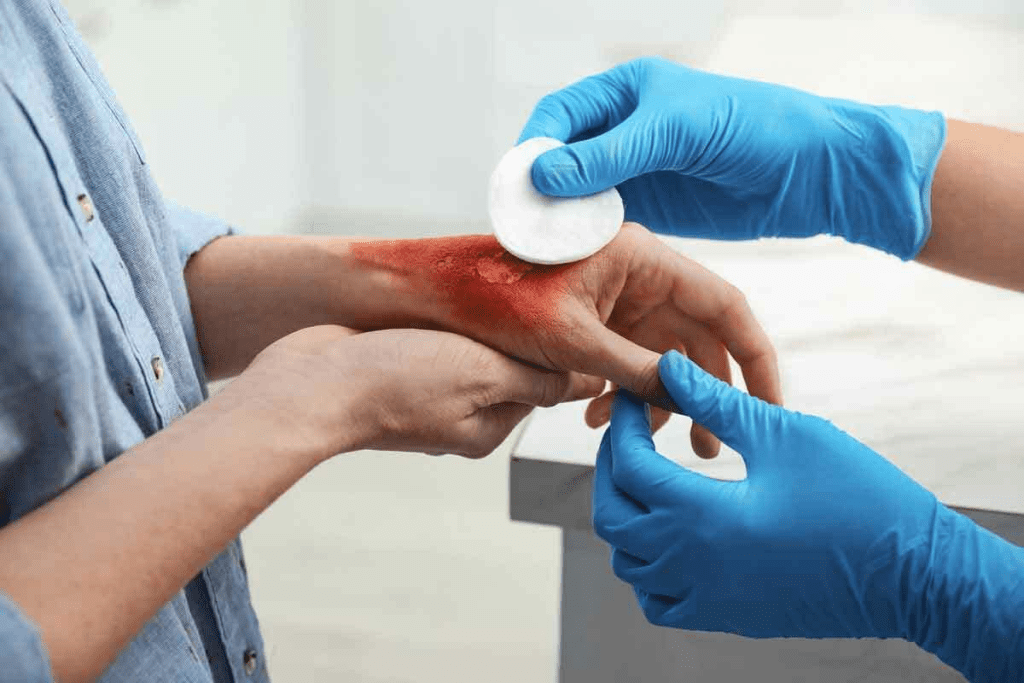Last Updated on November 27, 2025 by Bilal Hasdemir

Radiation therapy is a common way to treat cancer. But it can cause painful skin reactions, known as radiation dermatitis. Up to 95% of patients get this condition, which can be mild or very severe.
It’s important to treat and care for radiation burns well. This helps manage symptoms and prevent infections.
At Liv Hospital, we know how tough radiation burns can be. We’re dedicated to giving advanced care and support. We aim to help patients manage their symptoms and live better lives.
Key Takeaways
- Radiation dermatitis affects up to 95% of patients receiving radiotherapy.
- Symptoms can range from mild erythema to severe desquamation.
- Effective treatment focuses on infection prevention, pain management, and topical agents.
- Keeping the skin clean, dry, and moisturized can help prevent radiation burns.
- Several treatment options are available, including corticosteroid cream and antibiotics.
Understanding Radiation Burns from Cancer Treatment

Radiation dermatitis, or radiation skin reaction, is a common side effect of cancer treatment. It happens when radiation damages skin cells, causing redness, warmth, itchiness, and dryness. Knowing the causes and symptoms is key to managing it well.
What is Radiation Dermatitis?
Radiation dermatitis is a common side effect of radiation therapy. It affects the skin’s appearance and comfort. Symptoms can range from mild redness to wet skin peeling.
The severity of radiation dermatitis varies. It depends on the radiation dose, the treated area, and individual skin sensitivity.
How Common are Radiation Skin Reactions?
Radiation skin reactions are common in patients receiving radiation therapy. Most patients will experience some skin reaction during treatment. The severity can vary from mild to severe.
Timeline of Radiation Burn Development
Radiation skin reactions develop gradually during treatment. They usually affect only the treated area. Symptoms can start a few days into treatment and may get worse after treatment ends.
Understanding radiation burns is important. Awareness and proactive management help reduce their impact. By knowing about radiation dermatitis, its prevalence, and how it develops, patients and healthcare providers can work together to lessen its effects.
Identifying the Severity of Radiation Burns

Radiation burns show different signs based on their severity. It’s important to know these signs and symptoms. The severity can range from mild to severe, and understanding these differences is key to managing the condition.
Mild to Moderate Symptoms (Erythema and Dry Desquamation)
Mild radiation burns show as erythema, which is redness and inflammation of the skin. This is the first sign of radiation dermatitis. When it gets more serious, dry desquamation happens, where the skin dries and flakes off. It’s vital to keep the affected area moisturized to prevent further irritation.
Severe Manifestations (Moist Desquamation and Ulceration)
Severe radiation burns can lead to moist desquamation, where the skin is raw and weeps fluid. This increases the risk of infection and needs careful wound management. In the worst cases, ulceration can happen, causing open sores that are painful and hard to heal. Prompt medical attention is necessary to prevent complications.
What Do Radiation Burns Look Like at Different Stages?
Radiation burns go through several stages, and their appearance changes with each stage. At first, the skin may look red and inflamed (erythema). As it gets worse, it can turn into dry desquamation, then moist desquamation, and in the worst cases, ulceration. Knowing these stages helps healthcare providers and patients understand the burn’s severity and choose the right treatment.
By recognizing the signs and symptoms of radiation burns at different stages, we can create effective treatment plans. This personalized approach is essential for managing radiation burns and supporting patients during their cancer treatment.
Treatment #1: Topical Corticosteroids as a Cure for Radiation Burns
Topical corticosteroids are a key treatment for radiation burns. They help by reducing inflammation. These medications are used to manage skin reactions caused by radiation, from mild to severe.
How Corticosteroids Reduce Inflammation
Corticosteroids suppress the immune response in the skin. This reduces inflammation and prevents further damage. They do this by stopping the production of substances that cause inflammation.
By reducing inflammation, corticosteroids ease symptoms like redness, swelling, and itching. This makes them a good treatment for radiation burns.
Prescription Options and Their Strengths
There are many topical corticosteroid preparations, each with different strengths. Mild corticosteroids, like hydrocortisone cream, are good for mild reactions. More potent ones, like betamethasone valerate, are for more severe reactions.
The right corticosteroid and strength depend on the burn’s severity and the patient’s health.
Common prescription options include:
- Hydrocortisone cream (1%) for mild reactions
- Betamethasone valerate cream for moderate to severe reactions
- Clobetasol propionate cream for severe reactions
Application Guidelines and Possible Side Effects
To get the most from topical corticosteroids, follow the application guidelines. Apply the cream or ointment once or twice a day. The exact frequency and duration depend on the burn’s severity and how well you respond to the treatment.
Potential side effects of long-term corticosteroid use include:
- Skin thinning
- Telangiectasia (visible small blood vessels)
- Hypopigmentation
To avoid these risks, use the lowest effective dose for the shortest time. Regular check-ups with a healthcare professional are important. They help adjust the treatment plan and address any concerns.
Treatment #2: Specialized Dressings for Weeping Radiation Burns
Specialized dressings are key in treating weeping radiation burns from therapy. They manage moisture, aid in healing, and prevent infection.
Hydrocolloid Dressings and Their Benefits
Hydrocolloid dressings are great for weeping radiation burns. They keep the wound moist, which helps it heal. They also protect the wound from irritation.
These dressings absorb fluids, reducing the need for frequent changes. They also lower the chance of infection. Keeping the wound moist helps it heal faster and reduces pain.
Hydrogel Applications for Moisture Management
Hydrogel dressings are another choice for managing weeping radiation burns. They have a gel-like substance that keeps moisture in. This helps the wound heal.
They’re good for dry or peeling skin, as they moisturize and reduce discomfort. Hydrogel dressings can be used with other treatments for better results.
Techniques for Applying and Changing Dressings
Using the right technique when applying and changing dressings is important. It helps prevent infection and promotes healing. Clean the skin around the wound before applying a new dressing.
Remove any leftover adhesive carefully to avoid irritation. When changing dressings, check the wound for signs of infection. This includes redness, swelling, or more exudate. Monitoring the wound closely helps healthcare providers adjust the treatment plan for better results.
Treatment #3: Antimicrobial Solutions for Preventing Infection
Stopping infection is key to treating radiation burns. Antimicrobial solutions are vital in this fight. They help keep the skin safe from harmful bacteria and promote healing.
Silver Sulfadiazine and Other Silver-Based Products
Silver sulfadiazine is a top choice for fighting infection in radiation burns. It works well against many types of bacteria and fungi. Silver dressings also offer long-lasting protection against infection.
Key benefits of silver sulfadiazine include:
- Broad-spectrum antimicrobial activity
- Effective against a range of bacteria and fungi
- Promotes a clean environment for wound healing
Gentle Cleansing Protocols
Cleaning radiation burns gently is very important. Mild cleansers help keep the skin intact while removing harmful stuff. Avoiding harsh cleansers is key to not making things worse.
Best practices for gentle cleansing include:
- Using lukewarm water
- Avoiding harsh or abrasive cleansers
- Gently patting the area dry
Signs of Infection Requiring Medical Attention
Infections can happen even with prevention. Spotting signs early is critical. Look out for redness, swelling, pain, or pus, and fever or chills.
Signs that require immediate medical attention:
- Increased redness or swelling
- Pus or discharge
- Fever or chills
- Increased pain
Knowing about antimicrobial solutions, gentle cleaning, and infection signs helps everyone. Patients and healthcare teams can work better together to heal radiation burns.
Treatment #4: Natural Remedies and Plant-Based Solutions
Natural remedies for radiation dermatitis are getting more attention. Patients are looking for ways to manage radiotherapy skin burns. Some natural products might help ease symptoms and aid in healing.
Aloe Vera Preparations for Radiation Skin Burns
Aloe vera is a popular natural remedy for skin issues, including radiation dermatitis. Its gel has anti-inflammatory compounds that can soothe irritated skin.
A study in the Journal of Clinical Oncology showed that aloe vera gel works as well as a topical corticosteroid. It reduced radiation-induced skin toxicity in breast cancer patients. But more research is needed to confirm its effectiveness.
Benefits of Aloe Vera:
- Anti-inflammatory properties
- Moisturizing effects
- Potential to reduce symptoms of radiation dermatitis
Calendula Products and Clinical Evidence
Calendula, from marigold flowers, is another natural remedy for radiation skin reactions. It has anti-inflammatory and antimicrobial properties.
A clinical trial in the Journal of Alternative and Complementary Medicine found calendula cream reduces radiation dermatitis in breast cancer patients. It was more effective than a placebo.
| Product | Key Benefits | Clinical Evidence |
|---|---|---|
| Aloe Vera Gel | Anti-inflammatory, moisturizing | Mixed results;s ome studies show effectiveness |
| Calendula Cream | Anti-inflammatory, antimicrobial | Significant reduction in radiation dermatitis severity |
Other Botanical Treatments with Promising Results
Other botanical treatments are being explored for managing radiation skin burns. These include:
- Tea tree oil, known for its antimicrobial properties
- Chamomile, which may help soothe irritated skin
- Lavender oil potentially reduces inflammation and promotes sealing
While these natural remedies show promise, it’s important to talk to a healthcare provider before using them. They can help find the best approach for each case. This ensures safe use with conventional treatments.
Treatment #5: Specialized Barrier Creams and Moisturizers
Radiotherapy burns need special care. Barrier creams and moisturizers are key. They protect the skin, help it heal, and lower the chance of problems.
Silicone-Based Products for Skin Protection
Silicone-based products are great for radiotherapy burns. They make a protective layer on the skin. This layer stops friction and irritation. Silicone gel sheets are good for areas that get a lot of friction or are hard to cover.
Some benefits of these products are:
- Less chance of skin irritation and allergic reactions
- Good at managing moisture
- Easy to put on and take off
Non-Metallic Moisturizers Safe During Treatment
Non-metallic moisturizers are safe during radiation therapy. They keep the skin’s barrier function. Aqueous-based creams are best because they are gentle and don’t irritate the skin.
| Moisturizer Type | Benefits | Precautions |
|---|---|---|
| Aqueous-based creams | Gentle, non-irritating, keeps skin hydrated | Avoid applying too close to the time of radiation therapy |
| Silicone-based creams | Provides proa protective barrier, reduces friction | May not be suitable for all skin types; patch test recommended |
Application Timing: Before vs. After Radiation Sessions
When to apply barrier creams and moisturizers is important. Applying them before radiation sessions protects the skin. Applying them after sessions helps soothe and heal the skin.
It’s best to apply moisturizers:
- Right after radiation therapy, to soothe the skin
- At least 2 hours before radiation therapy to avoid affecting treatment
Knowing how barrier creams and moisturizers work helps patients and doctors. It makes treatment for radiotherapy burns better, making patients more comfortable and helping them heal faster.
Treatment #6: Pain Management Strategies for Radiation Blisters
Radiation therapy can cause painful skin reactions. This makes pain management very important. It helps patients feel better and live better lives. We will look at different ways to manage pain from radiation blisters. It’s all about finding what works best for each person.
Topical Analgesics and Cooling Treatments
Topical analgesics and cooling treatments are often the first step. They help numb the skin or cool it down. Topical analgesics with lidocaine or benzocaine are good for this. Cool compresses or gel packs can also help by reducing pain and swelling.
Oral Medications for Discomfort Relief
If topical treatments don’t work, oral medications might be needed. Nonsteroidal anti-inflammatory drugs (NSAIDs) and other pain relievers can help. It’s important to follow what your doctor says to avoid side effects.
Non-Pharmaceutical Approaches to Pain Control
There are also non-medical ways to manage pain. Techniques like meditation, deep breathing exercises, and gentle massage can help. They can be used along with other treatments to offer more relief.
Knowing about all these pain management options helps patients and doctors create the best care plans. This way, everyone can find a solution that meets their needs for radiation blister pain.
Treatment #7: Advanced Therapies for Severe Burns from Radiation Therapy
New treatments are being developed to help with severe burns from radiation therapy. These treatments aim to ease pain and help wounds heal for those with severe radiation dermatitis.
Plasma-Based Biomaterials: The Cutting Edge
Plasma-based biomaterials are a new way to treat severe radiation burns. They come from plasma, which has growth factors and proteins that help repair tissues. Research shows they can help wounds heal faster by boosting cell growth and strengthening tissues.
Key benefits of plasma-based biomaterials include:
- Enhanced wound healing
- Improved tissue regeneration
- Reduced risk of infection
Mesenchymal Stem Cell Treatments
Mesenchymal stem cell (MSC) treatments are being studied for severe radiation burns. MSCs can turn into different cell types, including skin cells. They also have anti-inflammatory effects that help wounds heal. Studies suggest MSC therapy can help wounds close faster and reduce skin damage from radiation.
Surgical Interventions for Chronic Radiation Wounds
For chronic radiation wounds, surgery might be needed. Procedures like debridement, skin grafting, and flap reconstruction are used. These aim to remove bad tissue, help wounds heal, and fix skin. Surgery is considered when other treatments don’t work well enough.
Knowing about these advanced therapies helps patients and doctors make better choices for treating radiation burns. These treatments offer hope for better outcomes and healing for those with severe burns.
Managing Radiation Burns During Ongoing Treatment
Managing radiation burns during treatment needs a mix of medical help and teaching patients. We will look at ways to lessen the effects of radiation therapy burns.
Communication with Your Radiation Oncology Team
Talking clearly with your radiation oncology team is key to handling radiation skin reactions. Patients should tell their team about any symptoms or worries right away. This helps the team make quick changes to the treatment plan if needed.
Key things to talk about with your radiation oncology team include:
- Severity of radiation burns
- Impact on daily activities
- Any pain or discomfort experienced
- Previous experiences with radiation therapy
When Treatment Modifications May Be Necessary
At times, changing the radiation treatment plan might be needed for severe burns. This could mean adjusting the amount of radiation or when it’s given.
| Treatment Modification | Potential Benefit |
|---|---|
| Reducing radiation dosage | Minimizes further skin damage |
| Adjusting treatment schedule | Allows skin to recover between sessions |
| Using alternative radiation techniques | May reduce skin exposure |
Balancing Effective Cancer Treatment with Skin Care
It’s a fine line to balance cancer treatment with skin care. We must make sure skin protection doesn’t harm the treatment’s success.
Ways to balance treatment and skin care include:
- Using topical treatments that are compatible with radiation therapy
- Implementing gentle skin care routines
- Monitoring skin reactions closely
Managing radiation burns during treatment needs teamwork between patients and healthcare providers. Understanding the importance of talking, possible treatment changes, and balancing treatment with skin care helps improve patient results.
Lifestyle Adjustments to Support Healing
Radiation burns need careful care, including lifestyle changes that help a lot. We help patients through tough times by changing daily habits. This helps them heal better.
Clothing Considerations for Irritated Skin
Choosing the right clothes is a big help. Loose, soft clothing makes skin feel better. Stay away from tight or rough clothes that can make skin worse.
Wearing natural fibers like cotton keeps skin cool and dry. This helps it heal faster.
Nutritional Support for Skin Recovery
Eating well is key to skin health and healing. Drinking enough water keeps skin flexible and helps it heal.
Studies show that vitamins C, zinc, and omega-3 fatty acids are good for skin. Eating foods rich in these can help a lot.
| Nutrient | Benefit | Food Sources |
|---|---|---|
| Vitamin C | Boosts collagen production, supports immune function | Citrus fruits, berries, leafy greens |
| Zinc | Supports wound healing, immune function | Red meat, poultry, seafood, beans |
| Omega-3 Fatty Acids | Reduces inflammation, supports skin health | Fatty fish, nuts, and seeds |
Physical Activity Modifications During Healing
Rest is important, but some exercise is good too. Low-impact exercises like yoga or short walks are okay. They keep blood flowing without hurting the skin too much.
It’s important to find a balance between moving and resting. Too much of either can hurt the healing process.
Conclusion: Creating Your Personalized Radiation Burn Care Plan
Creating a detailed radiation burn care plan is key to better patient outcomes and quality of life. Understanding the treatment options and making lifestyle changes helps manage radiation burns well.
We suggest patients team up with their radiation oncology team to craft a care plan that fits their needs. This teamwork allows doctors to guide on the best ways to treat radiation burns, ensuring top care.
By following the advice in this article and getting medical advice, patients can aid in healing, lessen pain, and boost their health during and after radiation therapy.
FAQ
What are radiation burns, and how do they occur?
Radiation burns, also known as radiation dermatitis, happen when radiation therapy damages skin cells. This leads to symptoms like redness, warmth, itchiness, and dryness.
How can I manage radiation burns during ongoing treatment?
To manage radiation burns, talk to your radiation oncology team. Make lifestyle changes and use treatments like topical corticosteroids and pain management.
What are the different stages of radiation burns?
Radiation burns can vary in severity. They range from mild redness to severe desquamation, including dry and moist desquamation, and ulceration.
How can I prevent infection in radiation burns?
Preventing infection in radiation burns involves using antimicrobial solutions and gentle cleansing. Also, watch for signs of infection that need medical attention.
What are some effective treatments for radiation burns?
Effective treatments include topical corticosteroids, specialized dressings, and antimicrobial solutions. Natural remedies, barrier creams, and moisturizers also help. Pain management and advanced therapies like plasma-based biomaterials and mesenchymal stem cell treatments are also options.
Can radiation burns be cured?
While radiation burns can be treated, the goal is to heal, reduce symptoms, and improve quality of life. It’s not about a complete “cure” in the classical sense.
How can I soothe and protect radiation-damaged skin?
To soothe and protect radiation-damaged skin, use gentle skincare products and avoid irritants. Apply barrier creams and moisturizers, like silicone-based products, for protection and relief.
What lifestyle adjustments can I make to support healing?
To support healing, make clothing considerations, provide nutritional support, and modify physical activity. These adjustments help promote comfort and recovery.
When should I seek medical attention for radiation burns?
Seek medical attention if you see signs of infection, like increased redness, swelling, or pus. Also, if your burns worsen or don’t respond to treatment.
Can I use natural remedies for radiation burns?
Natural remedies like aloe vera and calendula products may help. But always consult with your healthcare provider before trying new treatments.
References
- Practical recommendations for the management of radiodermatitis. (n.d.). . https://pmc.ncbi.nlm.nih.gov/articles/PMC11954187/
- Promoting Comfort: A Clinician Guide and Evidence-Based Skin Care Plan in the Prevention and Management of Radiation Dermatitis for Patients with Breast Cancer. (2022). Healthcare, 10(8), 1496. https://www.mdpi.com/2227-9032/10/8/1496






